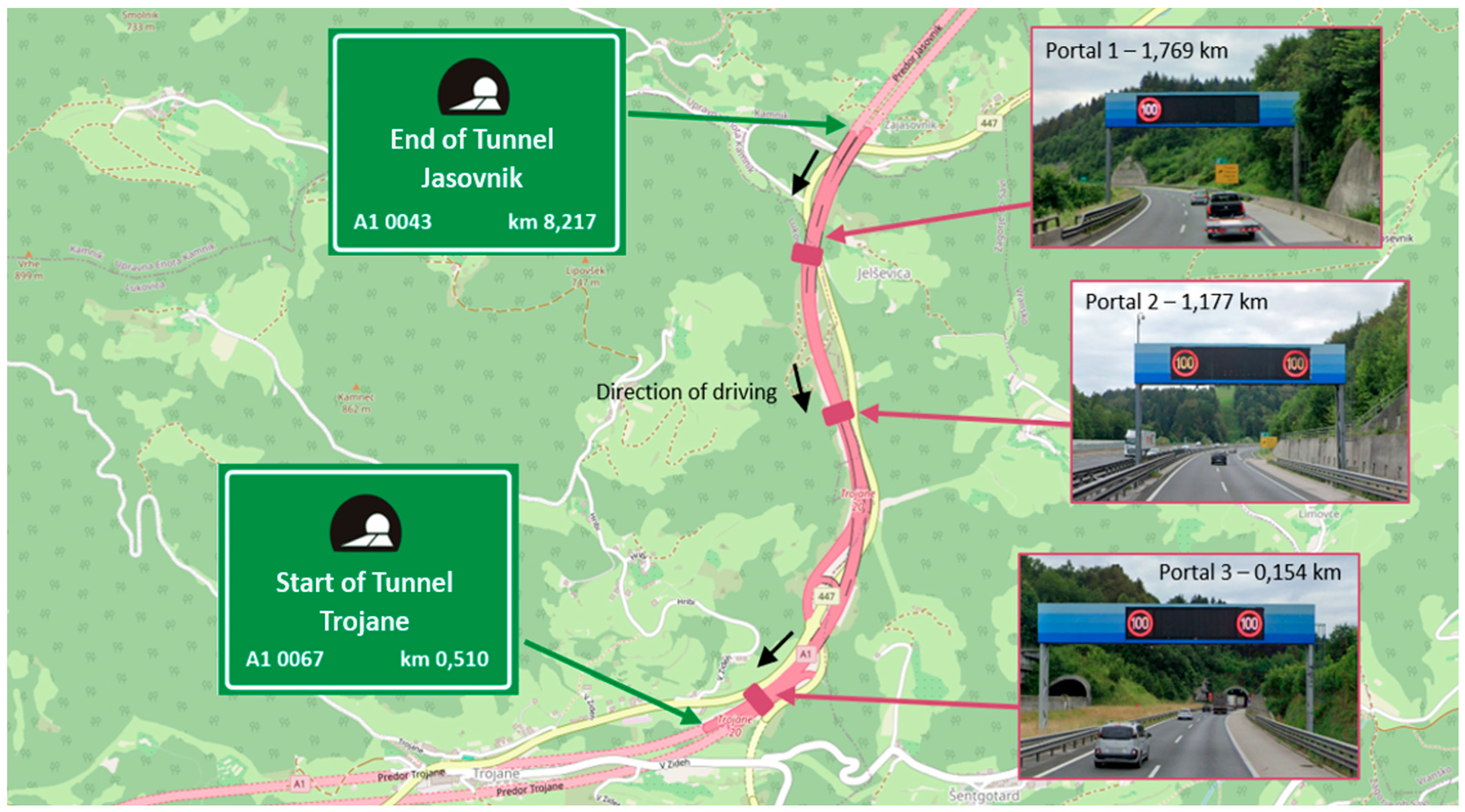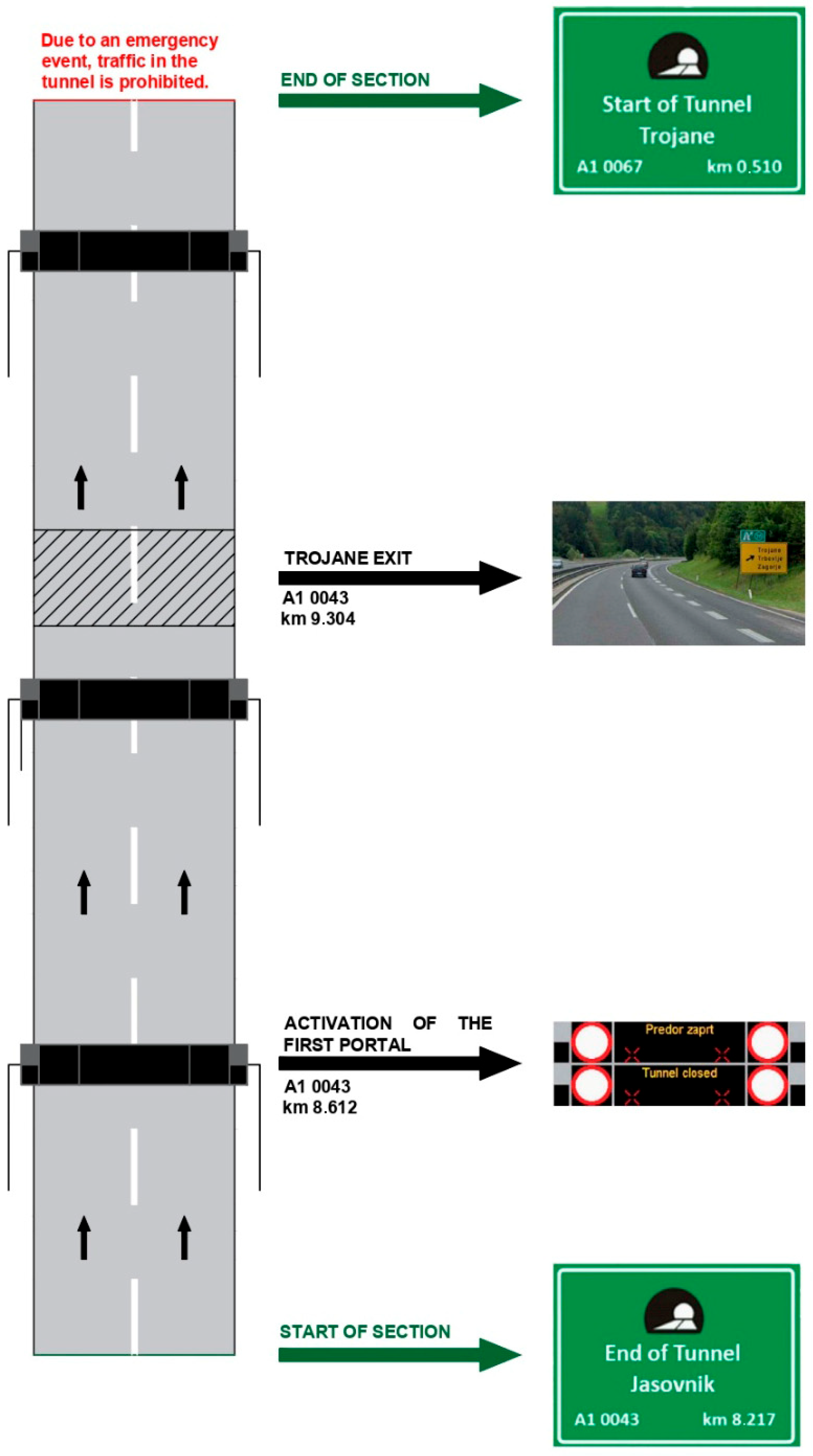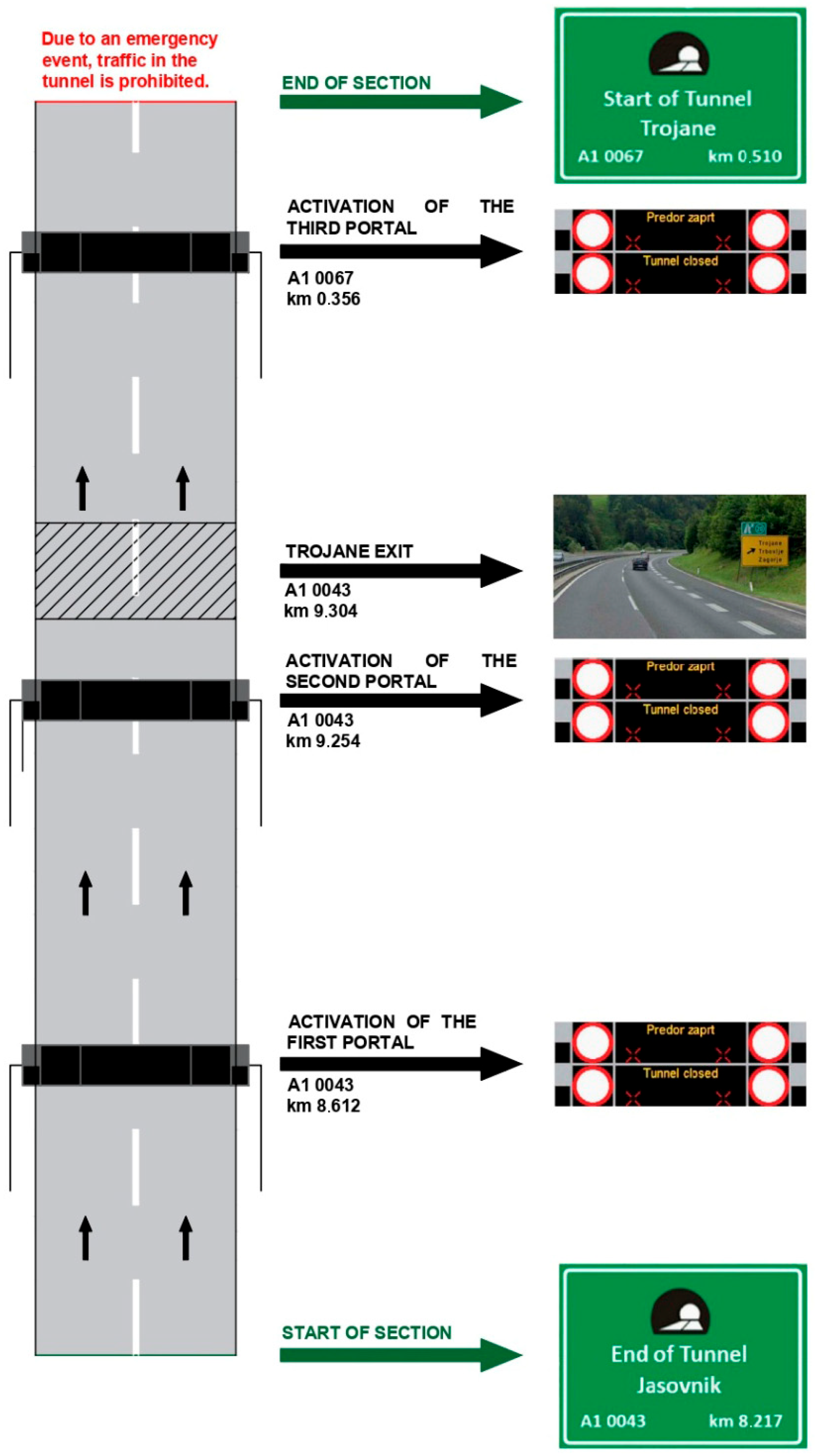3.1. ITS and C-ITS Infrastructure
On a Slovenian motorway network, two key ITSs are currently in use: the Traffic Control and Management System and the Tunnel Control and Management System. To manage these two systems, the motorway management company DARS operates the advanced Kažipot II information system, which enables the collection, processing, and distribution of traffic data in real time. Through this system, all key traffic information is immediately transmitted to the warning system and indirectly published on the promet.si website, RTV Slovenia teletext, telephone answering machines, and all radio stations. In addition, the system enables automated transmission of data to competent institutions, such as the police, the Slovenian Infrastructure Directorate, and the Ministry of Infrastructure, thus ensuring the rapid notification of all relevant services and improving responsiveness to potential traffic contracts. The Traffic Management and Control System should rapidly detect traffic accidents, congestion, and other emergency events and inform road users about current traffic conditions. It consists of various technological components to effectively monitor, control, and manage traffic in real time. These technologies include video surveillance cameras, sensors for measuring traffic density and speed, microwave detectors, variable traffic information signs (VTISs), weather stations, and height controls, which together enable a flexible and coordinated response to current road conditions.
Variable traffic information signs (VTISs) are devices that provide drivers with up-to-date information about traffic conditions, incidents, road works, or speed limits, using a combination of international symbols and text messages [
24,
25]. Messages include details of the incident (e.g., road works or accidents), location, consequences (e.g., lane closures or traffic jams), and recommended actions (e.g., reducing speed or taking an alternative route). These signs may also display graphical representations of traffic conditions and congestion. Both static and variable traffic signs use international symbols, enabling clear and universal communication that overcomes language barriers and ensures better understanding for drivers from different countries [
25]. These systems are adapted to the principles of Human Machine Interface (HMI) so that drivers receive only the necessary information at key points [
26]. In Slovenia, variable traffic signs enable effective real-time traffic management through various forms, such as portals, semi-portals, variable traffic signs, and variable signposts. Portals are installed at specific locations, above the whole lane width of the motorway to inform drivers about unexpected events, especially about congested sections or accidents and road works, enabling timely decisions and relief of critical sections [
27].
Regarding C-ITSs, currently in Slovenia, the PROMET+ mobile application is active. This application was developed to provide users with real-time access to traffic data via mobile networks, thereby enhancing the hybrid communication infrastructure. Ongoing pilot projects are currently testing communication between motorway management systems and vehicles through mobile networks, with the Promet+ application serving as a functional equivalent to an onboard unit (OBU). In this role, it delivers traffic information directly to users’ mobile devices. Beyond disseminating road condition updates, the application also supports virtual traffic signaling, enabling the transmission of critical information to vehicles even in situations where physical signage (e.g., portals before tunnels) is not visible due to adverse weather conditions such as fog or snow. The system presently operates on existing mobile networks, including 3G, 4G, and LTE, while the forthcoming transition to 5G is anticipated to significantly increase data transmission speed and reliability [
5].
3.2. Study Site and Data Collection
To conduct a comprehensive analysis of information transmission delays, this research focused on a specific case study, namely, the motorway section leading to the Trojane tunnel on the A1 motorway in the direction of Ljubljana, Slovenia. This segment was selected due to its infrastructural and operational significance, high traffic volumes, and the challenging geographic and traffic conditions that influence the performance of intelligent transport systems.
The analyzed section spans from the Jasovnik tunnel (stationing km 8.212 on section 0043) to the Trojane tunnel (stationing km 0.510 on section 0067), with a total length of 2.219 km (
Figure 1). Of this, 1.709 km belong to section 0043, and 0.510 km to section 0067, corresponding to the distance between kilometer markers 77.000 and 79.219 [
10,
11,
27]. The area lies within the municipalities of Lukovica and Zagorje ob Savi and forms a critical traffic corridor connecting central Slovenia with the Zasavje region.
Three ITS portals are installed along the section, enabling dynamic traffic management and real-time driver notifications. The first portal is located 1.769 km before the Trojane tunnel entrance, the second 50 m before the Trojane exit (1.177 km before the tunnel), and the third only 154 m from the tunnel entrance. All portals are connected to the Regional Control Centre (RCC) in Vransko, which enables remote management, the rapid detection of traffic conditions, and the corresponding adjustment of traffic signaling.
The effectiveness of ITSs and C-ITSs was evaluated based on two criteria: the number of drivers who were not informed about traffic conditions in time due to delayed information and a comparison of the time delays associated with different modes of information transmission. The analysis utilized data from traditional traffic information portals, representing conventional ITSs, and data from the Promet+ mobile application [
5], which serves as an example of a C-ITS-based solution.
The first step in the analysis consisted of determining the capacity of the section during peak traffic periods to estimate the number of vehicles passing through within a given time frame. Traffic volume and average speed data were obtained from the automatic traffic counter QLTC8, installed at measurement point 0067 Trojane–Blagovica.
The analysis was based on the concept of peak hour, which represents a fundamental element in traffic flow analysis, identifying the time interval with the highest traffic demand and therefore the most critical conditions for assessing capacity and level of service. Peak hour is generally defined as the consecutive 60 min period within a day that experiences the highest traffic volumes. In practice, traffic counts for determining the peak hour are typically carried out on working days between Tuesday and Thursday, since these days are considered to best reflect regular traffic conditions, while Mondays and Fridays often exhibit irregular patterns [
27]. In this study, the peak hour was determined on the basis of a 16 h traffic count conducted on the 16 October 2024. This day was chosen together with the experts of the motorway management company DARS, since no disruptions were recorded, making it suitable for assessing typical traffic flow. The analysis revealed two critical peak hours: the morning peak period between 05:30 and 06:30 and the afternoon peak period from 14:16 to 15:16, which were therefore taken as the representative time interval for further evaluation. During the morning peak (5:30–6:30), a total of 2.918 vehicles passed through the Trojane tunnel, 1.856 on the driving lane, and 1.062 on the overtaking lane. In the afternoon peak (14:16–15:16), 1.554 vehicles were recorded, 905 on the driving lane, and 649 on the overtaking lane. The average speed in both periods was approximately 101 km/h. All traffic flow data recorded during the peak hours are reported in
Table 1 and
Table 2.
However, it should be noted that transmission delay is largely independent of vehicle type. For C-ITS and ITS portals, delays are determined by the system’s detection, processing, and communication steps, rather than the type of vehicle receiving the message. Consequently, while
Table 1 and
Table 2 report vehicle counts, the effect of vehicle type on transmission delay was not analyzed. Building on this, the next step of the analysis compared four modalities for transmitting traffic information:
Manual transmission to ITS portals;
Automated transmission to ITS portals;
Manual transmission to the Promet+ mobile application;
Automated transmission to the Promet+ mobile application.
In cases when ITS portals are manually activated, traffic accidents are typically detected via video surveillance systems integrated into the Traffic Control and Management System and the Tunnel Supervisory Control System. Once an accident is identified, the data are processed locally with an average delay of around 10 s. This local processing step helps reduce the network load and improves the reliability of data transmission. The accident information is then forwarded to the Regional Control Centre (RCC), where a traffic manager assesses the situation. If the accident is confirmed and considered relevant, the operator manually activates the warning message on the appropriate traffic portals. Following this, the information is transmitted from the RCC to the portals themselves. According to 2024 data from the Vransko Regional Control Centre, the average transmission time to the portals located before the Trojane tunnel is approximately 11 s, based on system-exported data provided directly by DARS. Altogether, the entire process, from detection to the display of the warning, takes an average of 34 s, with the total delay largely influenced by the operator’s response time.
In contrast to manual activation, the automated transmission of information to ITS portals operates without any human intervention. The system autonomously detects critical events, such as wrong-way driving, smoke, or fire, and automatically initiates appropriate responses, including speed limit reductions, warning messages, or even tunnel closures. In the case of the Trojane tunnel, where video detection is implemented, there is an initial data delay of approximately 10 s. Once the event is detected, the data is transmitted within three seconds to the Kažipot system, i.e., the national traffic information system, where it is processed in about one second and immediately triggers the appropriate message on the portals. The subsequent transmission of this information to the portals takes an average of 11 s.
Despite the initial 10 s delay in detection, the entire process from event detection to message display takes approximately 25 s, allowing faster and more responsive alerts for drivers compared to manual activation. However, the duration of automated activation is not always consistent, as it may vary depending on factors such as weather conditions, network load, and specific system configurations. The data presented here is based on information provided by the developer of the ITSs currently used by DARS d.d.
A similar process applies to manual transmission to the Promet+ application. Once the accident is verified by the RCC operator, the data is transmitted to the Kažipot system, an interface which facilitates the integration with the mobile application. This additional transmission phase takes approximately four seconds, resulting in an average total delay of 27 s from initial detection to the app notification.
However, the shortest delay is achieved with fully automated C-ITS transmission to the Promet+ mobile application. In this case, the detected event is automatically validated within the Kažipot system, with no operator involvement. Upon validation, the warning is instantly transmitted to the application, requiring only four seconds. The total process, from detection to user notification takes an average of just 18 s, representing the fastest response time among all analyzed transmission methods and highlighting the key advantage of automated C-ITS solutions for timely traffic information dissemination.
Following the identification of peak traffic hours and the definition of different modes of traffic information transmission to drivers, a quantitative assessment of information effectiveness was conducted. This assessment involves calculating the number of drivers who are not informed of an accident in a timely manner and consequently lack the opportunity to take appropriate action, such as selecting an alternative route. Such situations can significantly contribute to traffic congestion, particularly in critical sections such as the Trojane tunnel.
The first part of the analysis focuses on information transmission to ITS portals, examining the impact of transmission delays on the timely dissemination of information to drivers. Specifically, the analysis evaluates how many drivers are not informed of an accident in time, thereby limiting their ability to choose alternate routes and potentially causing congestion before the Trojane tunnel.
The number of drivers not informed in a timely manner timely via the portal is calculated using Equation (1):
where
—number of drivers not informed in a timely manner via the portal [veh];
—distance from the portal to the closed tunnel or road section [km];
—minimum distance required for proper visibility of the portal [km];
—average vehicle speed during peak hour i [km/h];
—traffic flow during peak hour i [veh/s];
—information transmission delay to drivers [s].
The results of the performed analysis will highlight the difference in the number of drivers informed in a timely manner between manual and automated portal activation, further reinforcing the importance of automation within ITSs.
The second part of the analysis addresses the transmission of traffic information via the Promet+ mobile application, representing a modern component of a C-ITS framework. This part of the study focuses on two update scenarios: continuous updating, where the application constantly monitors the system and immediately triggers an alert when an event is detected, and periodic updating, where the application queries the system for new information at 60 s intervals.
In both scenarios, the analysis evaluates the impact of manual and automated activation of information transmission and calculates how many drivers are not informed in a timely manner about an incident, under the assumption that all drivers have the Promet+ application installed, with sound notifications enabled and visual alerts properly configured. For continuous Promet+ updates, the number of uninformed drivers is determined solely by the transmission delay multiplied by the traffic flow, reflecting those who encounter an event before the alert reaches them.
In the case of continuous updating, the number of drivers not informed in time is calculated as follows (2):
where
—number of drivers not informed in a timely manner via Promet+ continuous update [veh];
—transmission delay [s];
—traffic flow during peak hour i [veh/s].
However, due to high battery consumption, the Promet+ application currently operates in a periodic update mode with a 60 s interval. This trade-off between energy efficiency and information timeliness directly affects a driver’s ability to respond to unexpected events, as delayed information may mean a missed opportunity to divert to an alternative route.
Since the exact moment when the application will fetch and display new information cannot be predicted under fixed intervals, the analysis considers the worst-case scenario. This occurs when an accident is detected immediately after an update has just been completed, resulting in the next update occurring only after the full 60 s interval. When combined with the system’s own processing delay, this introduces a significant latency.
The impact of this delay is quantified using Equation (3):
where
—number of drivers not informed in a timely manner via Promet+ with 60 s periodic updates [veh];
—system transmission delay [s];
—traffic flow during peak hour i i [veh/s].
This equation accounts for both the system delay and the fixed update interval, providing an estimate of drivers who may miss the alert under the worst-case timing scenario, assuming uniform traffic flow.
The methodology described enables a quantitative assessment of the effectiveness of various traffic information transmission methods and the impact of time delays on timely driver awareness. Based on the presented data and equations, the following section will provide specific calculations for each scenario, along with graphical representations that illustrate the differences between manual and automated information transmission via variable message signs and the PROMET+ mobile application.















